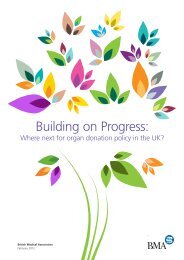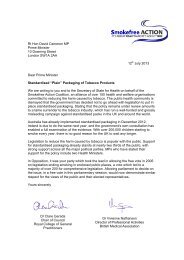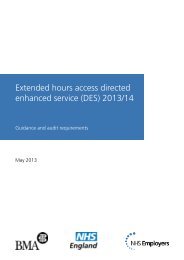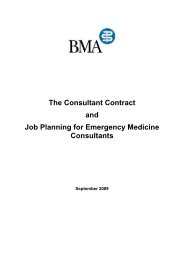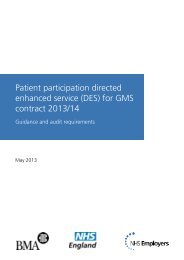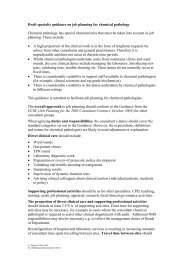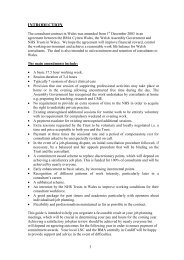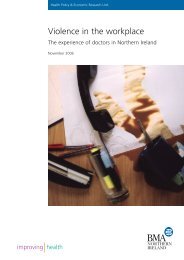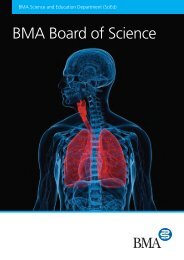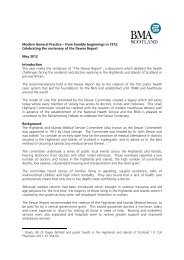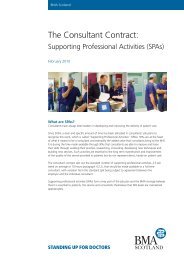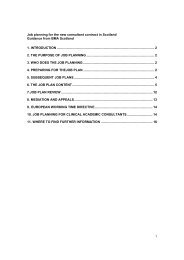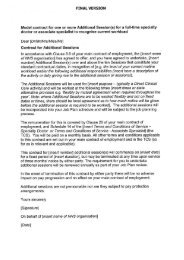Examples of consultants' objectives - BMA
Examples of consultants' objectives - BMA
Examples of consultants' objectives - BMA
Create successful ePaper yourself
Turn your PDF publications into a flip-book with our unique Google optimized e-Paper software.
Background<br />
Page 1 <strong>of</strong> 40<br />
Objective Setting - A Resource for Devising and<br />
Agreeing Objectives in the 2003 Consultant Contract<br />
A consultant job plan should be a prospective agreement that sets out a consultant’s duties,<br />
responsibilities and <strong>objectives</strong> for the coming year. Since the 2003 contract (schedule 3, paragraphs 10-<br />
13) this has explicitly included the agreement <strong>of</strong> personal and service <strong>objectives</strong>. They should cover all<br />
aspects <strong>of</strong> a consultant’s role, including personal development, and they should be directly relevant to<br />
your work, focusing on patient benefit.<br />
What are Objectives?<br />
Objectives are mutually agreed aims which the consultant and his/her manager think would usefully<br />
develop the service, the consultant or both. They should be based on the SMART (Specific, Measureable,<br />
Achieveable, Resourced, Timed) system. There should be a balance between service <strong>objectives</strong> that could<br />
be shared as part <strong>of</strong> a team and personal development <strong>objectives</strong>. Objectives should be set for most <strong>of</strong><br />
the activities in the job plan and they should set out mutual understanding <strong>of</strong> what the trust and<br />
consultant aim to achieve in coming year and how this will contribute to team, service and organisational<br />
<strong>objectives</strong>.<br />
Why would consultants want to use <strong>objectives</strong>?<br />
They provide a significant opportunity for consultants, as clinical leaders, to set the agenda for their trusts<br />
and put forward the needs <strong>of</strong> their patients. We recommend consultants and departments are proactive<br />
in this area for the benefit <strong>of</strong> their patients.<br />
Objectives – how does the process work?<br />
Objectives should be discussed and agreed during job planning meetings. They should cover direct clinical<br />
care and supporting pr<strong>of</strong>essional activities. It will be important to bring knowledge <strong>of</strong> trust <strong>objectives</strong> and<br />
service requirements into the objective-setting discussions. The clinical director should have an overview<br />
<strong>of</strong> <strong>objectives</strong>, seek the views <strong>of</strong> colleagues and achieve a consensus. It is also essential that you are able<br />
to identify the supporting resources you will need in order to carry out your <strong>objectives</strong> when you agree<br />
your job plan.<br />
How to use these examples<br />
These examples show <strong>objectives</strong> in a range <strong>of</strong> specialties and subspecialties that are designed to help<br />
consultants to develop <strong>objectives</strong> <strong>of</strong> their own. There are a range <strong>of</strong> drivers – clinical governance and<br />
quality, teaching and research, service developments, personal goals and team <strong>objectives</strong> should all be<br />
taken into account when job plans are agreed. Consultants will have their own ideas about how services<br />
can be improved so it is important to balance these with input from management and colleagues.<br />
To adapt these examples for practical use you may need to expand on the detail, but consultants should<br />
be able to approach an objective without detailed supervision using pr<strong>of</strong>essional flexibility. This will vary<br />
according to the capacities <strong>of</strong> the clinical manager and consultant. All your <strong>objectives</strong> and progress in<br />
achieving them should be discussed in your job plan review meeting. However, the review process for<br />
<strong>objectives</strong> should not be restricted to that meeting. Clinical directors will need to consider inputs from<br />
other sources.<br />
How many specific <strong>objectives</strong> should you have in your job plan?<br />
<strong>Examples</strong> <strong>of</strong> good practice vary from six to eight. An important principle is to balance personalised service<br />
<strong>objectives</strong> with personal development <strong>objectives</strong>. We suggest that you balance these two categories and
choose three or four <strong>of</strong> each (not all will be completed within one year). In this way you will be devoting<br />
your time to improving yourself as a consultant and the service that you <strong>of</strong>fer to your patients. The<br />
examples <strong>of</strong> <strong>objectives</strong> in this guide will help you to identify and agree the <strong>objectives</strong> in your job plan.<br />
Building on the examples <strong>of</strong> good practice and suggestions for actual <strong>objectives</strong>, you will be able to enter<br />
job plan meetings with confidence. If you have any feedback on this guide please contact us:<br />
info.cc@bma.org.uk<br />
Related resources<br />
We recommend you do not use these examples in isolation. Search for job planning on the <strong>BMA</strong> website<br />
here: www.bma.org.uk (The web site will serve a better selection if you log in). Key documents are on the<br />
‘job planning’ page, here http://bma.org.uk/practical-support-at-work/contracts/job-planning<br />
The key document you will need is A Guide to Consultant Job Planning, 2011. This was prepared jointly<br />
by the <strong>BMA</strong> and NHS Employers and reflects a shared understanding <strong>of</strong> the key principles which should<br />
characterise a collaborative approach to the job planning process.<br />
The NHS Employers website also has some useful documents here www.nhsemployers.org. Click on the<br />
‘pay and contracts’ section, then the ‘consultants and dental consultants’ page. Key documents are:<br />
• Effective job planning – a concise guide for consultants, 2005. This is in the job planning toolkit<br />
section <strong>of</strong> the web site. This deals particularly well with objective setting.<br />
• Consultant job planning – standards <strong>of</strong> best practice, 2003. This is in the ‘guidance’ section and<br />
details the contractual standards.<br />
• Job planning handbook, 2005. This was produced by the Consultant Contract Implementation<br />
Team in the Department <strong>of</strong> Health, and contained some sample <strong>objectives</strong> for consultants. It is in<br />
the ‘job planning toolkit’ section.<br />
You should also refer to the web sites run by your medical royal college and specialty associations, which<br />
may contain advice on job planning and <strong>objectives</strong>.<br />
Page 2 <strong>of</strong> 40
Personalised service <strong>objectives</strong> - examples<br />
Reducing hospital acquired infection rates .......................................................................................4<br />
Reducing infections with Clostridium difficile ...................................................................................5<br />
Undertaking junior doctor inductions...............................................................................................6<br />
Using incident reports to anticipate problems ..................................................................................7<br />
Changing working methods to reduce on call frequency .................................................................8<br />
Appointing a new consultant colleague ...........................................................................................9<br />
Improving diagnostics turnaround..................................................................................................10<br />
Promoting same day admissions ....................................................................................................11<br />
Establishing a non-physician endoscopist .......................................................................................12<br />
mproving efficiency in theatres ......................................................................................................13<br />
Developing an Allied Health Pr<strong>of</strong>essional service ............................................................................14<br />
Introducing a screening service ......................................................................................................15<br />
Assuring consultant-led resuscitation .............................................................................................16<br />
Improving inpatient health.............................................................................................................17<br />
After care service for critical care survivors .....................................................................................18<br />
Performance monitoring <strong>of</strong> clinical outcomes ................................................................................19<br />
Reducing iatrogenic complications.................................................................................................20<br />
Reducing drug budgets..................................................................................................................21<br />
Increasing use <strong>of</strong> outpatient treatments.........................................................................................22<br />
Reducing needless outpatient visits................................................................................................23<br />
Improving screening service ...........................................................................................................24<br />
Improving postoperative analgesia.................................................................................................25<br />
Controlling the caesarean delivery rate ..........................................................................................26<br />
Monitoring progress in chronic disease ..........................................................................................27<br />
Maximising organisational earned income .....................................................................................28<br />
Reducing delayed discharge...........................................................................................................29<br />
Supervision <strong>of</strong> specialist training ....................................................................................................30<br />
Implementing ‘rapid access to service’ target .................................................................................31<br />
Reducing time to see new patients in OPD.....................................................................................32<br />
Personal development <strong>objectives</strong> - examples<br />
Completing CEPD and mandatory training.....................................................................................33<br />
Undertaking a research project ......................................................................................................34<br />
Measuring comparative clinical performance .................................................................................35<br />
Acquiring a new clinical skill ..........................................................................................................36<br />
Maintaining basic knowledge ........................................................................................................37<br />
Becoming a college examiner.........................................................................................................38<br />
Completing an evidence based guideline .......................................................................................39<br />
Developing interview skills .............................................................................................................40<br />
Page 3 <strong>of</strong> 40
Personalised service <strong>objectives</strong> - examples<br />
Reducing hospital acquired infection rates<br />
Suitable for Consultant.<br />
Objective<br />
To reduce hospital acquired infection rates.<br />
Actions to achieve objective<br />
Annual hand hygiene and antibiotic prescribing updates.<br />
Reports raised where observed practice is inadequate.<br />
Success criteria and measures<br />
Team criterion: infection control audit shows increased compliance rates and<br />
reduced thrombophlebitis rates.<br />
Agreed review process and timetable<br />
Quarterly infection control audits at clinical audit meeting.<br />
Confirmed attendance at minimum two meetings per year.<br />
Support required (including removal <strong>of</strong> organisational barriers)<br />
Appropriate consumables present in all locations.<br />
Hand washing sinks installed in all clinical locations.<br />
Effective action on this is a high priority for many trust boards. This objective can easily be modified to be<br />
more specific and look at infection rates as they apply to ward patients in any specialty. However, it<br />
would not be appropriate to make one consultant responsible for all instances <strong>of</strong> infection where there<br />
are many factors leading to infection. Like any objective, it has to be something specific that the<br />
consultant can achieve.<br />
Page 4 <strong>of</strong> 40
Reducing infections with Clostridium difficile<br />
Suitable for Consultant.<br />
Objective<br />
To reduce the number <strong>of</strong> C. difficile cases in my ward<br />
Actions to achieve objective<br />
Team prescribing practice to comply with trust antibiotic policy.<br />
All senior and junior medical staff to undergo mandatory training in prescribing and in<br />
infection control/hand washing.<br />
Success criteria and measures<br />
Mandatory training records complete for team.<br />
Antibiotic audit shows adherence to agreed trust guidelines.<br />
Agreed review process and timetable<br />
Monthly antibiotic report.<br />
Mandatory training records considered at annual job plan review.<br />
Support required (including removal <strong>of</strong> organisational barriers)<br />
Pharmacy collation <strong>of</strong> data and ward pharmacist audit <strong>of</strong> prescriptions.<br />
Administrative support to coordinate mandatory training.<br />
This objective looks at a different area <strong>of</strong> infection control and focuses on the consultant’s leadership<br />
position. As team leader the consultant is ideally placed to make sure that the dull but necessary<br />
procedures are in place to guide antibiotic prescribing and to limit spread <strong>of</strong> infection on the hands or<br />
clothes <strong>of</strong> the team. Another success criterion might be a reduction in the number <strong>of</strong> cases. However, this<br />
may be too blunt a measure as infection should be rare anyway and the causes multifactorial and beyond<br />
the consultant’s direct control.<br />
Page 5 <strong>of</strong> 40
Undertaking junior doctor inductions<br />
Suitable for Consultant.<br />
Objective<br />
To improve the induction process for junior doctors in order to gain CNST<br />
certification at level 2.<br />
Actions to achieve objective<br />
Use education session to develop a series <strong>of</strong> subject specific tutorials.<br />
Involve the associate specialists as providers for some sessions.<br />
Success criteria and measures<br />
Register <strong>of</strong> attendance (CNST requirement) and course programme – 80%<br />
attendance on day, 100% catch-up within four weeks for modular completion.<br />
Written feedback from new trainees for each induction session.<br />
Agreed review process and timetable<br />
Annual meeting with clinical tutor to review outcomes as reported by inductees.<br />
Attendance checked with each new house.<br />
Support required (including removal <strong>of</strong> organisational barriers)<br />
“Bleep free” time for juniors to attend – divisional action.<br />
Postgraduate centre to coordinate sessions and analyse feedback.<br />
CNST have a criterion based on the induction process for staff members, and this consultant will be<br />
helping to achieve that certification. It’s always tempting but rarely realistic to set 100% success criteria,<br />
even where this relates to mandatory training, so in this objective a more realistic target is set. However,<br />
approaching 100% will reduce the size <strong>of</strong> the task in catching up over the following four weeks.<br />
Page 6 <strong>of</strong> 40
Using incident reports to anticipate problems<br />
Suitable for Laboratory consultant.<br />
Objective<br />
To improve quality surveillance and increase ability <strong>of</strong> department to identify problem<br />
areas early.<br />
Actions to achieve objective<br />
Change prevailing culture to increase incident reporting and error logging.<br />
Collect more <strong>of</strong> the actual incidents and increase diversity <strong>of</strong> staff making reports.<br />
Success criteria and measures<br />
Number <strong>of</strong> reports, number <strong>of</strong> staff making reports.<br />
Minuted discussion <strong>of</strong> issues in each local laboratory meetings.<br />
Agreed review process and timetable<br />
Quarterly analysis by clinical governance <strong>of</strong>fice.<br />
Both qualitative measures to increase 20% over last year.<br />
Support required (including removal <strong>of</strong> organisational barriers)<br />
Analytical support from clinical governance <strong>of</strong>fice.<br />
Laboratory meeting to be held monthly (laboratory and clinical management to<br />
ensure).<br />
Incident reporting is difficult because it is so counterintuitive to have an increase in the number <strong>of</strong><br />
reported incidents as a desirable outcome. However, the culture that incidents are not reported needs to<br />
be changed if preventive action is to be taken in time. Furthermore, it is better that more staff make<br />
reports since this will increase the likelihood <strong>of</strong> catching important incidents.<br />
Page 7 <strong>of</strong> 40
Changing working methods to reduce on call frequency<br />
Suitable for Consultant orthopaedic surgeon.<br />
Objective<br />
To reduce onerous on call rota frequency and enhance patient care and safety.<br />
Actions to achieve objective<br />
Explore options for wider on call cover groups for specialties such as hand trauma<br />
and spine emergency.<br />
• Shared with larger groups in same specialty with clinical guidelines to support<br />
immediate reception care before definitive care next morning.<br />
• Shared with same subspecialty on county-wide basis.<br />
Success criteria and measures<br />
Establishment <strong>of</strong> changed working practice agreed between clinicians and SHA.<br />
Abolition <strong>of</strong> all remaining subspecialty consultant rotas 1:4 or more frequent.<br />
Agreed review process and timetable<br />
Three months to identify preferred solution and agree with divisional director.<br />
Twelve months to implementation if consultation results in agreement.<br />
Support required (including removal <strong>of</strong> organisational barriers)<br />
Commissioning director to assist with cross-boundary consultation.<br />
Managerial support for business case for identified solution.<br />
The end result is clear here but the means <strong>of</strong> achieving it not so. This objective calls for the consultant to<br />
develop an appropriate solution to a common problem in subspecialty work, the high frequency <strong>of</strong> the<br />
consultant on call rota and the increasing component <strong>of</strong> direct clinical care expected <strong>of</strong> the consultants<br />
under the traditional arrangements. The nature <strong>of</strong> the preferred solution is les important than that it is<br />
initiated by and attracts support from the local clinicians.<br />
Page 8 <strong>of</strong> 40
Appointing a new consultant colleague<br />
Suitable for Consultant (lead clinician).<br />
Objective<br />
To appoint a new consultant colleague and thereby enhance quality <strong>of</strong> care and<br />
ability to achieve 18-week target.<br />
Actions to achieve objective<br />
To identify with consultants in specialty and agree PAs that can be re-allocated to job<br />
plan for a new consultant, reducing average to 10-11 range.<br />
Draw up appropriate job plan and job description, take through approval and engage<br />
with medical staffing to organise AAC.<br />
Success criteria and measures<br />
Appointment <strong>of</strong> new consultant.<br />
Agreed review process and timetable<br />
New consultant to commence work within one year.<br />
Support required (including removal <strong>of</strong> organisational barriers)<br />
Trust management to assist in developing business case and funding for new<br />
consultant.<br />
Medical staffing to organise AAC.<br />
Appointing a new consultant colleague is a complex process and this objective gives part <strong>of</strong> that task to<br />
one consultant who is probably already a lead clinician. Their role will be identifying a suitable job plan<br />
for the new appointment in negotiation with existing consultants, and taking it though the process with<br />
medical staffing. The support required includes that <strong>of</strong> management in taking the new job plan through<br />
the appropriate organisational approvals.<br />
Page 9 <strong>of</strong> 40
Improving diagnostics turnaround<br />
Suitable for Consultant radiologist.<br />
Objective<br />
To improve turnaround <strong>of</strong> GP radiology reporting.<br />
Actions to achieve objective<br />
Assess current reporting pathway and identify bottlenecks that could be addressed.<br />
Devise methods to reduce these points <strong>of</strong> delay.<br />
Success criteria and measures<br />
Presentation <strong>of</strong> business case to divisional board for changed working.<br />
Reduction <strong>of</strong> turnaround time to preset target.<br />
Agreed review process and timetable<br />
Bi-monthly report to clinical director or service improvement group (as appropriate).<br />
Reduction in monthly turnaround times <strong>of</strong> at least 10% by one year.<br />
Support required (including removal <strong>of</strong> organisational barriers)<br />
Access to and support from radiology service manager, RIS manager or PACS<br />
manager.<br />
Departmental/hospital service improvement facilitator (as appropriate to department).<br />
This objective has a measurable and specific outcome measure, relating to diagnostics reporting<br />
turnaround times. Some imagination will be needed to assess the current pathway and come up with a<br />
range <strong>of</strong> solutions without just asking for more resource – although that may be the eventually necessity.<br />
Page 10 <strong>of</strong> 40
Promoting same day admissions<br />
Suitable for Consultant surgeon – clinical director.<br />
Objective<br />
To reduce length <strong>of</strong> stay for surgical patients by introducing same day admissions.<br />
Actions to achieve objective<br />
Enable patients to be admitted on the day <strong>of</strong> surgery:<br />
• Examine and reform preoperative process including anaesthesia assessment.<br />
• Formulate design criteria for on-day patient reception area.<br />
Success criteria and measures<br />
Reduced length <strong>of</strong> hospital stay.<br />
Fewer same-admission cancellations (all reasons).<br />
Agreed review process and timetable<br />
Monthly review with divisional medical director on project status.<br />
Expected completion at one year.<br />
Support required (including removal <strong>of</strong> organisational barriers)<br />
Business case support for identified solutions.<br />
Clinical buy-in to concept <strong>of</strong> same day admissions.<br />
Too <strong>of</strong>ten changed working practices are introduced which do not have support among clinicians and<br />
which then suffer from reduced effectiveness. This is a high-level objective for an existing medical<br />
manager who will need to consider how to enlist the help <strong>of</strong> consultant colleagues across several<br />
departments, along with the nurses and other clinical staff. Formulating it in this way keeps the<br />
responsibility for the solution with the clinical leadership <strong>of</strong> the hospital.<br />
Page 11 <strong>of</strong> 40
Establishing a non-physician endoscopist<br />
Suitable for Consultant physician.<br />
Objective<br />
To increase the availability <strong>of</strong> endoscopy procedures through establishing a nonphysician<br />
endoscopy position.<br />
Actions to achieve objective<br />
Lead appointments procedure for new post.<br />
Success criteria and measures<br />
Able to perform colonoscopy fully independently within twelve months.<br />
Colonic intubation rate to be no lower than average for physician endoscopists.<br />
Agreed review process and timetable<br />
Appointment within six months.<br />
Independent colonoscopy within twelve months <strong>of</strong> appointment.<br />
Support required (including removal <strong>of</strong> organisational barriers)<br />
Business case in place.<br />
Medical staffing support for appointments process.<br />
Adequate time in job plan (part SPA and part DCC) to deliver theoretical and<br />
practical components <strong>of</strong> training.<br />
With the business case in place the identification <strong>of</strong> a suitable individual and their training is a role for a<br />
consultant. The trust has accepted the necessary investment <strong>of</strong> consultant time in order to improve the<br />
service in the long term.<br />
Page 12 <strong>of</strong> 40
Improving efficiency in theatres<br />
Suitable for Consultant anaesthetist.<br />
Objective<br />
To improve theatre efficiency by addressing case turnover.<br />
Actions to achieve objective<br />
Undertake ‘lean thinking’ review with theatre teams to identify amenable<br />
unproductive time.<br />
Make presentation to divisional board on recommendations for changed practice.<br />
Implement agreed changes.<br />
Success criteria and measures<br />
Sustained 25% reduction in case turnaround as measured by ‘last out – next in’ on<br />
theatre information system.<br />
Agreed review process and timetable<br />
Audit reported at quarterly divisional management board meetings.<br />
Support required (including removal <strong>of</strong> organisational barriers)<br />
Theatre information team support.<br />
Involvement and backfilling <strong>of</strong> sufficient staff for kaizen event and training.<br />
Complaints about theatre efficiency can too <strong>of</strong>ten become complaints about unproductive members <strong>of</strong><br />
the team while not recognising the necessity <strong>of</strong> the team working together. An objective such as this<br />
requires concentration on multidisciplinary involvement to complete successfully and has a specific<br />
measurable success criterion.<br />
Page 13 <strong>of</strong> 40
Developing an Allied Health Pr<strong>of</strong>essional service<br />
Suitable for Consultant haematologist.<br />
Objective<br />
To devise and introduce trust thromboprophylaxis guideline.<br />
Actions to achieve objective<br />
Write evidence based guideline and take through medical advisory board.<br />
Embed use <strong>of</strong> thromboprophylaxis assessment forms into practice for all inpatients.<br />
Success criteria and measures<br />
Audit figure shows uptake <strong>of</strong> greater than 90%.<br />
Agreed review process and timetable<br />
In place – two months.<br />
Audit compliance > 80% - four months.<br />
Support required (including removal <strong>of</strong> organisational barriers)<br />
Clinical governance <strong>of</strong>ficer to hold documents, arrange printing and conduct<br />
snapshot audit.<br />
Board support to secure cross-organisational buy-in.<br />
Although the logical end point might be thought to be a reduction in the rate <strong>of</strong> death from pulmonary<br />
embolism, this is rare and so is a poor indicator <strong>of</strong> success at the objective. Performance is however<br />
critically dependent on doctors filling in more forms, traditionally a badly-regarded activity. The board<br />
demands 100% but realistic success criteria are needed.<br />
Page 14 <strong>of</strong> 40
Introducing a screening service<br />
Suitable for Consultant radiologist.<br />
Objective<br />
To assess the practicality <strong>of</strong> introducing a screening service for abdominal aortic<br />
aneurysm<br />
Actions to achieve objective<br />
Assess the likely demand, resources needed and estimated costs.<br />
Develop links with vascular services and primary care.<br />
Success criteria and measures<br />
Developed outline business case.<br />
Agreed review process and timetable<br />
Bimonthly report to directorate meeting.<br />
Complete within planning review year<br />
Support required (including removal <strong>of</strong> organisational barriers)<br />
Access to vascular service managers and vascular surgeons.<br />
Support from ultrasound service manager and trust business planners<br />
An objective does not have to result in actual change; this one results in the information on which a<br />
decision can be taken, information which has not been available before.<br />
Page 15 <strong>of</strong> 40
Assuring consultant-led resuscitation<br />
Suitable for Consultant in emergency medicine.<br />
Objective<br />
To ensure that trauma resuscitations are consultant led.<br />
Actions to achieve objective<br />
Direct presence: clearly designated consultant rota for resuscitation.<br />
Leadership: implementation <strong>of</strong> ED specific resuscitation training programme.<br />
Leadership: audit <strong>of</strong> clinical records <strong>of</strong> patients received by trauma team.<br />
Success criteria and measures<br />
All doctors leading resuscitation to be department-certified.<br />
Records audit to demonstrate reduction in serious pathway errors.<br />
Agreed review process and timetable<br />
Biannual review with Resuscitation Committee.<br />
Support required (including removal <strong>of</strong> organisational barriers)<br />
Sufficient EM consultants to allow dedicated clinical time.<br />
Administrative staff to conduct audit<br />
Consultant-led resuscitation is a requirement arising out <strong>of</strong> NCEPD reports; this encompasses direct<br />
presence much <strong>of</strong> the time and a review process for those where a consultant is not present.<br />
Page 16 <strong>of</strong> 40
Improving inpatient health<br />
Suitable for Consultant psychiatrist.<br />
Objective<br />
To improve the physical health <strong>of</strong> acute psychiatric inpatients.<br />
Actions to achieve objective<br />
Every acute admission should have a full physical examination within 24 hours or as<br />
soon as is practical.<br />
Every patient should have appropriate investigations completed in one week.<br />
Success criteria and measures<br />
Examination compliance rate as recorded in medical record.<br />
Proportion <strong>of</strong> ‘at risk’ patients who have had CXR and CT brain scans.<br />
Agreed review process and timetable<br />
Quarterly returns by ward managers on patients who have not been examined.<br />
Six-monthly clinical audits, randomly applied across all wards.<br />
Support required (including removal <strong>of</strong> organisational barriers)<br />
All wards should be stocked with equipment for physical examination.<br />
Adoption <strong>of</strong> this standard by trust audit committee for regular audit.<br />
The objective <strong>of</strong> increasing health is potentially a very wide one but this objective breaks it down to<br />
something achievable by an individual consultant who can improve this area <strong>of</strong> practice.<br />
Page 17 <strong>of</strong> 40
After care service for critical care survivors<br />
Suitable for Consultant intensivist or neonatologist.<br />
Objective<br />
To introduce a comprehensive after care service for critical care survivors.<br />
Actions to achieve objective<br />
See patients and carers following life threatening events to provide counselling and<br />
rehabilitation packages.<br />
Success criteria and measures<br />
Improvement <strong>of</strong> quality <strong>of</strong> life measurable by questionnaire.<br />
Revise critical care specific management tool and adopt at governance meeting.<br />
Agreed review process and timetable<br />
Use CHKS to provide data on patient follow-up.<br />
Quality <strong>of</strong> life reported at audit meetings and assessed at appraisal.<br />
Support required (including removal <strong>of</strong> organisational barriers)<br />
Management support for business case.<br />
Finance set up and running costs for weekly clinic plus multidisciplinary support.<br />
Introducing this new service will need investment by the employer; promoting the case for this<br />
investment will be assisted by the clear and measurable criteria for success defined in the objective.<br />
Page 18 <strong>of</strong> 40
Performance monitoring <strong>of</strong> clinical outcomes<br />
Suitable for Consultant surgeon.<br />
Objective<br />
To engage in performance monitoring <strong>of</strong> clinical outcomes.<br />
Actions to achieve objective<br />
To review quarterly reports <strong>of</strong> performance: personal and comparative within<br />
department.<br />
Success criteria and measures<br />
Validation confirmation sheet to be returned and logged.<br />
Improvement in measures identified at appraisal within one year.<br />
Agreed review process and timetable<br />
Quarterly returns to consultant and governance department.<br />
Annual review at appraisal.<br />
Support required (including removal <strong>of</strong> organisational barriers)<br />
Management commitment to supply the data in time for validation.<br />
Time and administrative support for departmental meetings.<br />
This objective asks the consultant to review the available information on their practice. However, this will<br />
not be possible without the supporting resources listed – too many consultants have the experience that<br />
they would like to review the information on their performance but are not enabled to do so.<br />
Page 19 <strong>of</strong> 40
Reducing iatrogenic complications<br />
Suitable for Consultant intensivist.<br />
Objective<br />
To reduce ventilator associated pneumonia in critical care.<br />
Actions to achieve objective<br />
Lead process <strong>of</strong> devising local guideline on care bundle.<br />
Lead education process for critical care nurses.<br />
Success criteria and measures<br />
Compliance figures for ventilator bundle >95%.<br />
Reductions in VAP rate and increase in days since last VAP.<br />
Agreed review process and timetable<br />
Monthly review <strong>of</strong> figures at critical care governance meeting.<br />
Annual report to divisional board.<br />
Support required (including removal <strong>of</strong> organisational barriers)<br />
Education release for training for nursing staff.<br />
Support for purchase <strong>of</strong> necessary consumables.<br />
This objective has a tight review process and stretching criterion for success, reflecting the importance <strong>of</strong><br />
preventing ventilator associated pneumonia. Its successful completion depends on the provision <strong>of</strong> the<br />
supporting resources as listed.<br />
Page 20 <strong>of</strong> 40
Reducing drug budgets<br />
Suitable for Consultant anaesthetist.<br />
Objective<br />
To reduce overspend on sev<strong>of</strong>lurane budget.<br />
Actions to achieve objective<br />
Devise and complete audit <strong>of</strong> current usage patterns.<br />
Devise and implement rational use guidelines.<br />
Success criteria and measures<br />
25% cost improvement on sev<strong>of</strong>lurane usage.<br />
Or reasons for lack <strong>of</strong> progress reported and understood.<br />
Agreed review process and timetable<br />
Monthly purchase order tracking.<br />
Clinical audit <strong>of</strong> FGF and volatile patterns at six months.<br />
Support required (including removal <strong>of</strong> organisational barriers)<br />
Detailed costings and analysis support from Pharmacy.<br />
Full implementation <strong>of</strong> anaesthesia machine programme.<br />
High expenditure on almost any expensive but non-mandatory drug is amenable this sort <strong>of</strong> approach in<br />
which an individual consultant takes responsibility for leading on the development <strong>of</strong> rational use<br />
guidelines.<br />
Page 21 <strong>of</strong> 40
Increasing use <strong>of</strong> outpatient treatments<br />
Suitable for Consultant neurologist.<br />
Objective<br />
To increase proportion <strong>of</strong> MS patients receiving infusion therapy as a day case.<br />
Actions to achieve objective<br />
Agree clinical guideline for patient selection for day case.<br />
Promote use through quality <strong>of</strong> care meetings.<br />
Audit use <strong>of</strong> steroids and monoclonal therapy – inpatient, outpatient and day case.<br />
Success criteria and measures<br />
Month on month increase in proportion <strong>of</strong> day case patients.<br />
Agreed review process and timetable<br />
Audit within three months.<br />
Business plan within six months.<br />
Completion within twelve months.<br />
Support required (including removal <strong>of</strong> organisational barriers)<br />
Funding and establishment <strong>of</strong> dedicated day case infusion unit.<br />
Analysis <strong>of</strong> drug use by pharmacy.<br />
This objective requires a significant resource investment for successful completion. In return for that<br />
investment there are clear success criteria for the consultant to achieve.<br />
Page 22 <strong>of</strong> 40
Reducing needless outpatient visits<br />
Suitable for Consultant with outpatient practice.<br />
Objective<br />
Reduce number <strong>of</strong> follow up clinic appointments in line with agreed local<br />
development plan.<br />
Actions to achieve objective<br />
Engage with PCT to agree appropriate new:FU ratio for speciality.<br />
Devise clinical guideline for registrars governing criteria for follow up.<br />
Success criteria and measures<br />
Achievement <strong>of</strong> agreed ratio within one year.<br />
No increase in re-referral rate.<br />
Agreed review process and timetable<br />
Monthly report on new:FU ratio<br />
Clinical audit <strong>of</strong> all patients in top 5% <strong>of</strong> distribution.<br />
Support required (including removal <strong>of</strong> organisational barriers)<br />
Data presented within one month for validation.<br />
SPA time and facilities for analysis <strong>of</strong> data and case audit.<br />
Monitoring the effective utilisation <strong>of</strong> clinic resources is probably something that every consultant with an<br />
outpatient practice should be doing; it does require time and data support in order to undertake<br />
effectively. Adequate SPAs are essential for this.<br />
Page 23 <strong>of</strong> 40
Improving screening service<br />
Suitable for Consultant obstetrician.<br />
Objective<br />
To achieve early diagnosis <strong>of</strong> Down’s Syndrome to allow patient a choice <strong>of</strong> action.<br />
Actions to achieve objective<br />
Introduce early Down’s Screening – Nuchal scans, Pap A and β-HCG.<br />
Establish robust patient information and invitation process.<br />
Success criteria and measures<br />
Halving number <strong>of</strong> mothers not <strong>of</strong>fered screening by 13 weeks gestation.<br />
Continual decrease in medical abortion for fetal anomaly.<br />
Agreed review process and timetable<br />
Quarterly monitoring <strong>of</strong> screening figures – one year to halve non-<strong>of</strong>fers.<br />
Annual review <strong>of</strong> medical abortion rates.<br />
Support required (including removal <strong>of</strong> organisational barriers)<br />
Establishment <strong>of</strong> administrative function to run screening process.<br />
Diagnostics contract with registered laboratory.<br />
As technology advances the services that can be <strong>of</strong>fered increase. This objective starts from the<br />
acceptance that the change is necessary; the success criteria are based around the improved patient<br />
service that should be expected for this investment.<br />
Page 24 <strong>of</strong> 40
Improving postoperative analgesia<br />
Suitable for Consultant anaesthetist.<br />
Objective<br />
To improve immediate postoperative analgesia in thoracic patients and decrease<br />
unplanned ICU admission.<br />
Actions to achieve objective<br />
Achieve establishment <strong>of</strong> perioperative regional blockade in guideline and practice.<br />
Establish education programme in pain management for recovery nursing staff.<br />
Success criteria and measures<br />
Improvement in pain scoring.<br />
Decreased reintubation rates with feedback to recovery nursing staff and thoracic<br />
anaesthetic group.<br />
Agreed review process and timetable<br />
To be reviewed with CD, theatre users group and CTICU intensivists group.<br />
Poor postoperative analgesia can not only increase pain scores in patients, a concern for humane reasons,<br />
but it can increase the rate <strong>of</strong> complications such as postoperative hypercapnia and ICU admission. Many<br />
such problems can be thrown up during a clinical audit, perhaps undertaken for another reason.<br />
Resolving them is an ideal project to assign to a consultant.<br />
Page 25 <strong>of</strong> 40<br />
• 3-monthly review using the pain team ongoing audit <strong>of</strong> pain scoring.<br />
• 6-monthly review <strong>of</strong> thoracic patient admissions to ICU.<br />
Support required (including removal <strong>of</strong> organisational barriers)<br />
Educational support for both medical and nursing staff.<br />
Formal database for thoracic HDU with IT support.
Controlling the caesarean delivery rate<br />
Suitable for Consultant obstetrician.<br />
Objective<br />
To reduce elective caesarean rate for breech presentation.<br />
Actions to achieve objective<br />
To maximise uptake <strong>of</strong> external cephalic version by ensuring all women with breech<br />
presentation are counselled about it.<br />
Success criteria and measures<br />
100% <strong>of</strong> eligible women given information and an interview with an obstetrician.<br />
Reduce planned CS for breech presentation to less than 60% <strong>of</strong> eligible women.<br />
Agreed review process and timetable<br />
Audit <strong>of</strong> provision <strong>of</strong> written information.<br />
Audit <strong>of</strong> planned CS for breech presentation.<br />
These audits to be undertaken on a project basis by a midwife. Achievement within<br />
one year.<br />
Support required (including removal <strong>of</strong> organisational barriers)<br />
Audit department support.<br />
Illustration department to design patient information leaflet.<br />
There is a great emphasis on achieving a high rate <strong>of</strong> normal deliveries and to reduce caesarean delivery.<br />
It is a huge problem and here it has been broken down into one achievable objective, that <strong>of</strong> maximising<br />
the use <strong>of</strong> ECV so as to reduce needless caesarean for breech presentation.<br />
Page 26 <strong>of</strong> 40
Monitoring progress in chronic disease<br />
Suitable for Consultant psychiatrist.<br />
Objective<br />
To carry out annual psychiatric review <strong>of</strong> outpatients with schizophrenia to note<br />
mental state, medication and psychological review.<br />
Actions to achieve objective<br />
Establish additional outpatients capacity in a consultant job plan.<br />
Establish mechanism to identify and invite all patients with schizophrenia.<br />
Success criteria and measures<br />
Record <strong>of</strong> attendance and recommendations in case notes – 90%.<br />
Sustained reduction in rate <strong>of</strong> unexpected admissions to less than 80% <strong>of</strong> present<br />
level.<br />
Agreed review process and timetable<br />
At annual job plan review.<br />
Consultant to identify any difficulties with patient attendance and bring to review.<br />
Support required (including removal <strong>of</strong> organisational barriers)<br />
Administration support for database to identify and record outcome.<br />
Clinical time to administer and carry out review.<br />
The consultant has identified the need for improvement <strong>of</strong> the state <strong>of</strong> health in apparently stable mental<br />
health patients, although this means what essentially are clinics devoted to follow up. The objective is a<br />
way <strong>of</strong> recording the organisational acceptance <strong>of</strong> this within the consultant’s job plan.<br />
Page 27 <strong>of</strong> 40
Maximising organisational earned income<br />
Suitable for Consultant.<br />
Objective<br />
To ensure that data accuracy in coding supports billing for the correct tariff payment.<br />
Actions to achieve objective<br />
Undertake audit to identify extent <strong>of</strong> inaccuracy using existing guidelines and quantify<br />
potential revenue loss.<br />
Establish modified operating procedure and clinical oversight to reduce inaccuracy.<br />
Success criteria and measures<br />
95% accuracy on diagnostic codes at snapshot audit.<br />
Revenue increase <strong>of</strong> 5% for same activity (criterion confirmed after audit).<br />
Agreed review process and timetable<br />
Three months to obtain data on present system.<br />
Quarterly review thereafter with divisional finance manager.<br />
Support required (including removal <strong>of</strong> organisational barriers)<br />
Information system to supply material for audit and analytical support.<br />
Regular liaison sessions with coding clerks.<br />
There is a difference between what we do and what the information system says we do. Bringing the two<br />
closer together is important and is facilitated by this objective, which is essentially that <strong>of</strong> ‘owning the<br />
data’ while the organisation as a whole benefits from maximised income.<br />
Page 28 <strong>of</strong> 40
Reducing delayed discharge<br />
Suitable for Consultant geriatrician.<br />
Objective<br />
To reduce delayed discharge <strong>of</strong> elderly patients.<br />
Actions to achieve objective<br />
Establish procedures to speed up investigation process e.g. wait for CT scans.<br />
Representative <strong>of</strong> medical team at daily discharge planning meeting on each ward.<br />
Success criteria and measures<br />
No patient waiting more than two days for inpatient investigations.<br />
Agreed criterion-based discharge plans in all case notes within two days <strong>of</strong><br />
admission.<br />
Agreed review process and timetable<br />
Monthly review at divisional board.<br />
Annual review <strong>of</strong> engagement in process at job plan review.<br />
Support required (including removal <strong>of</strong> organisational barriers)<br />
Senior management to assist in negotiating service agreements with social services,<br />
mental health trust.<br />
Delayed discharge is a common reason for failure to achieve activity targets such as the four-hour<br />
maximum time in the emergency department. It also could lead to patient harm: the development <strong>of</strong><br />
hospital associated complications such as thrombosis and infection. Many NHS trusts will be focused<br />
keenly on this area. This objective breaks the problem down to one area susceptible to intervention by<br />
one consultant working as part <strong>of</strong> the clinical team.<br />
Page 29 <strong>of</strong> 40
Supervision <strong>of</strong> specialist training<br />
Suitable for Pain management consultant.<br />
Objective<br />
To ensure specialty registrars are appropriately trained in management <strong>of</strong> acute and<br />
chronic pain conditions.<br />
Actions to achieve objective<br />
Review <strong>of</strong> Royal College syllabus against local practices.<br />
Personal clinical supervision and weekly review meetings.<br />
Success criteria and measures<br />
StR completes modular assessment.<br />
Achievement logged with college tutor.<br />
Agreed review process and timetable<br />
Quarterly reports to college tutor.<br />
Support required (including removal <strong>of</strong> organisational barriers)<br />
Allocated PAs in schedule for educational supervision.<br />
Trust support for StR taking appropriate study leave.<br />
Department to allocate StR for consistent module in pain management.<br />
With this objective one <strong>of</strong> the organisational barriers is addressed; it is difficult to train junior doctors<br />
when they are repeatedly removed from the specialist area in order to provide basic emergency service<br />
elsewhere. Identifying this at the job plan meeting focuses the mind <strong>of</strong> the clinical manager on the<br />
importance <strong>of</strong> removing this barrier to the consultant’s progress against the objective.<br />
Page 30 <strong>of</strong> 40
Implementing ‘rapid access to service’ target<br />
Suitable for Consultant physician – lead clinician.<br />
Objective<br />
To meet the changing requirements on the 31/62 day targets for lung cancer from<br />
December 2008.<br />
Actions to achieve objective<br />
Close working with new lung cancer coordinator post.<br />
Consultation with primary care trust and representatives.<br />
Devise and implement new patient pathway.<br />
Success criteria and measures<br />
Proportion <strong>of</strong> patients who are within target compared with the required standards –<br />
at least 30% improvement on first audited figure in first six months.<br />
Number breaches and analyses <strong>of</strong> breaches – monthly review with expectation <strong>of</strong><br />
month-on-month reduction to completion at one year.<br />
Agreed review process and timetable<br />
Monthly review with clinical director and lung cancer co-ordinator.<br />
Support required (including removal <strong>of</strong> organisational barriers)<br />
General management support for clinic reorganisation.<br />
Business case development for specialist nurse practitioner post.<br />
Additional responsibility PA time.<br />
This objective is required by movements in external expectations on the service. The actions to achieve the<br />
objective range widely inside and outside the trust and will need time in the consultant’s job plan,<br />
probably as an additional NHS responsibility reflecting the lead clinician role.<br />
Page 31 <strong>of</strong> 40
Reducing time to see new patients in OPD<br />
Suitable for Consultant orthopaedic surgeon.<br />
Objective<br />
Reduce working time for new referrals to OPD and help achieve 18-week RTT target.<br />
Actions to achieve objective<br />
Lead the team in exploring new ways <strong>of</strong> working and pathways.<br />
Appoint and develop the role <strong>of</strong> extended scope practitioners (ESP) in physiotherapy<br />
for ‘see and treat’ clinic in defined conditions.<br />
Implement triage sessions<br />
Success criteria and measures<br />
Reduce wait from ten weeks to six weeks.<br />
Feasibility report on further reduction to three weeks.<br />
Agreed review process and timetable<br />
Monthly review <strong>of</strong> access times with clinical director.<br />
Chosen solution to be identified within two months.<br />
Reduction to be achieved in three months after introduction <strong>of</strong> chosen solution.<br />
Support required (including removal <strong>of</strong> organisational barriers)<br />
Consultants’ scheduled time to triage referrals and support initiative.<br />
Trust to develop business case and fund arrangement <strong>of</strong> ESP physiotherapist.<br />
18 weeks is a central target for many trusts now. Downloading it into consultant <strong>objectives</strong> is useless<br />
without an intelligent approach, where each consultant’s contribution to the overall strategic objective is<br />
clarified. In that way each consultant’s role in the process can be reviewed without the job plan meeting<br />
descending into a state <strong>of</strong> learned helplessness.<br />
Page 32 <strong>of</strong> 40
Personal development <strong>objectives</strong> - examples<br />
Completing CEPD and mandatory training<br />
Suitable for Consultant.<br />
Objective<br />
To ensure that CEPD meets personal development and service needs.<br />
Actions to achieve objective<br />
Review service standards and mandatory training needs.<br />
Arrange and attend training.<br />
Success criteria and measures<br />
CEPD record is maintained in line with standards.<br />
Mandatory training undertaken and declared.<br />
Agreed review process and timetable<br />
Reviewed at annual job planning meeting.<br />
Successful revalidation (relicensure and recertification).<br />
Support required (including removal <strong>of</strong> organisational barriers)<br />
Adequate funding and time release for study leave and internal training.<br />
Trust to notify consultant <strong>of</strong> personal mandatory training needs.<br />
Trust to organise sufficient mandatory training sessions to be able to attend in SPA<br />
time.<br />
Mandatory training records are increasingly being checked by external bodies and will have a role in<br />
revalidation. Some trusts have supported consultant mandatory training by mounting two weeks each<br />
year in which rotating programmes <strong>of</strong> all the necessary training are <strong>of</strong>fered, allowing consultants to<br />
attend all elements in SPA time.<br />
Page 33 <strong>of</strong> 40
Undertaking a research project<br />
Suitable for Consultant – academic or NHS.<br />
Objective<br />
To carry out a research project.<br />
Actions to achieve objective<br />
Identify collaborators, develop research ‘question’ and write protocol.<br />
Apply for research governance and ethical approval; investigate funding sources.<br />
Success criteria and measures<br />
Publication or presentation <strong>of</strong> research.<br />
Award <strong>of</strong> research grant.<br />
Agreed review process and timetable<br />
Reviewed at six-monthly intervals with director <strong>of</strong> research.<br />
Support required (including removal <strong>of</strong> organisational barriers)<br />
Peer review, mentorship and training.<br />
NHS or university research and development <strong>of</strong>ficer / department support.<br />
SPA time for research in job plan.<br />
There is now a complex NHS research approval process which takes time, expertise and support. Much<br />
research is now collaborative which requires putting the research team in place as a research leader and<br />
identifying the support and roles <strong>of</strong> each <strong>of</strong> the participants. Research grant capture is becoming much<br />
more competitive but local sources <strong>of</strong> funding are available.<br />
Doctors participating in research should have appropriate time for research training, needed to enable<br />
consultants to process the paperwork required. Sufficient time to take part in the research is essential as<br />
is the need to identify the support required for success, identifying a mentor and a local supportive<br />
informal peer review process will increase the chances <strong>of</strong> successful research and grant capture.<br />
Page 34 <strong>of</strong> 40
Measuring comparative clinical performance<br />
Suitable for Consultant anaesthetist.<br />
Objective<br />
To assess the quality <strong>of</strong> recovery <strong>of</strong> my patients by comparison with colleagues.<br />
Actions to achieve objective<br />
Follow local guidelines for symptom prevention and treatment.<br />
Validate and consider provided audit data on personal practice.<br />
Success criteria and measures<br />
All patients to have antiemesis and analgesia prescribed and administered in line<br />
with local clinical guideline where this exists.<br />
All suitable patients to have nerve block in conjunction with systemic analgesia.<br />
Agreed review process and timetable<br />
Reviewed as part <strong>of</strong> the clinical audit programme each year.<br />
Data to be validated and returned each month as provided by audit department.<br />
Support required (including removal <strong>of</strong> organisational barriers)<br />
Audit department support for rolling audit.<br />
Clinical guideline for recovery staff with criteria for discharge or review, and<br />
education programme to put this into practice.<br />
Patient recovery after procedures is important in theatre activity but also as an end point for anaesthesia<br />
care. Pain is important but so is nausea and vomiting. The origin <strong>of</strong> these symptoms is complex and their<br />
prevention is multi-factorial; anaesthetists have a great role to play here. This objective looks at the<br />
problem in context and provides a way <strong>of</strong> determining whether the consultant’s practice lies significantly<br />
outside what colleagues can achieve in the same workplace.<br />
Page 35 <strong>of</strong> 40
Acquiring a new clinical skill<br />
Suitable for Consultant surgeon.<br />
Objective<br />
To learn and develop skills in laparoscopic colorectal surgery.<br />
Actions to achieve objective<br />
Complete review with clinical director as to suitability <strong>of</strong> cases in present practice and<br />
tariff implications.<br />
Arrange and undertake CEPD attachment at training centre coordinated by APCGBI.<br />
Success criteria and measures<br />
Successful completion <strong>of</strong> programme.<br />
Agreed review process and timetable<br />
Dry lab and wet lab courses inside six months.<br />
Cases to commence in own hospital inside twelve months.<br />
Support required (including removal <strong>of</strong> organisational barriers)<br />
Reallocation <strong>of</strong> SPA time and some study leave for attachment and skills courses.<br />
Caseload reduction to support initiation <strong>of</strong> solo lists.<br />
Acquiring a new skill as a consultant is a great challenge when placed alongside continuing an existing<br />
practice. The investment in training for the future has to be supported by clinical management. Using an<br />
objective is an ideal way to record that agreement and the envisaged timescales and support.<br />
Page 36 <strong>of</strong> 40
Maintaining basic knowledge<br />
Suitable for Consultant.<br />
Objective<br />
To keep up to date on basic core topics as defined by the Royal College.<br />
Actions to achieve objective<br />
Regular journal reading in the core journals for the discipline.<br />
Attendance at one general education meeting (out <strong>of</strong> subspecialty interest) per year.<br />
Success criteria and measures<br />
Description <strong>of</strong> reflections on practice at annual appraisal.<br />
Attendance certificate from education meeting.<br />
Agreed review process and timetable<br />
Recurrent annual review at appraisal.<br />
Support required (including removal <strong>of</strong> organisational barriers)<br />
SPA time and <strong>of</strong>fice facilities for reading and reflection.<br />
Funded and agree study leave.<br />
Keeping up to date on new developments is vital to good medical practice. Recognition that this involves<br />
some relatively unstructured activities will encourage inspiration to strike as the consultant consolidates<br />
core topics and is exposed to new ideas. Most consultants should have such an objective in their minds<br />
and in their job plans.<br />
Page 37 <strong>of</strong> 40
Becoming a college examiner<br />
Suitable for Consultant with an interest in education.<br />
Objective<br />
To become an examiner for the Royal College pr<strong>of</strong>essional examinations.<br />
Actions to achieve objective<br />
Attend examinations as visitor.<br />
Attain educational qualification at the university.<br />
Success criteria and measures<br />
Recognition as college examiner.<br />
Completion <strong>of</strong> master’s course at university.<br />
Agreed review process and timetable<br />
Recognition as examiner within two years.<br />
Sharing skills by becoming co-director <strong>of</strong> local exam course.<br />
Support required (including removal <strong>of</strong> organisational barriers)<br />
Study leave to complete qualification.<br />
Pr<strong>of</strong>essional leave to the extent <strong>of</strong> two weeks per year as examiner.<br />
SPA time for local teaching.<br />
Becoming a college examiner is a significant undertaking for a consultant and a significant investment for<br />
an employer. Using an objective in this way allows the extent <strong>of</strong> that investment and support to be<br />
qualified along with outlining the return on that investment.<br />
Page 38 <strong>of</strong> 40
Completing an evidence based guideline<br />
Suitable for Consultant obstetrician.<br />
Objective<br />
To complete a local clinical guideline in operative vaginal delivery required for CNST<br />
certification.<br />
Actions to achieve objective<br />
Undertake evidence based review <strong>of</strong> area.<br />
Consult with colleagues in own and other departments.<br />
Success criteria and measures<br />
Guideline approved by clinical governance committee and added to CNST portfolio.<br />
Guideline into clinical practice at agreed date.<br />
Agreed review process and timetable<br />
Reviewed within three months with CNST lead clinician.<br />
Implementation date set within four months.<br />
Support required (including removal <strong>of</strong> organisational barriers)<br />
Library support for evidence base.<br />
Clerk to maintain this as part <strong>of</strong> the CNST portfolio.<br />
Producing a guideline portfolio for external inspection is a daunting task when faced by one individual.<br />
Clinical directors can use <strong>objectives</strong> to share the task around a number <strong>of</strong> consultants, but another<br />
important focus here is to increase the number <strong>of</strong> consultants who have skills in writing appropriate local<br />
clinical guidelines.<br />
Page 39 <strong>of</strong> 40
Developing interview skills<br />
Suitable for Consultant.<br />
Objective<br />
To prepare for sitting as a member <strong>of</strong> interview panels.<br />
Actions to achieve objective<br />
Undertake training for interviewing:<br />
Complete e-learning module on diversity and equality.<br />
Attend course in employment law.<br />
Success criteria and measures<br />
Pass online test at the end <strong>of</strong> the module.<br />
Achieve certificate <strong>of</strong> attendance on the employment law course.<br />
Agreed review process and timetable<br />
To be completed within the next year and assessed at appraisal.<br />
Support required (including removal <strong>of</strong> organisational barriers)<br />
Leave to attend course in employment law.<br />
Entrenching learning into practice by sitting as regular panel member.<br />
This may be a low-key objective but it does provide a focus for a consultant who may be finding difficulty<br />
in allocating time to develop a role beyond their usual clinical practice.<br />
Page 40 <strong>of</strong> 40



